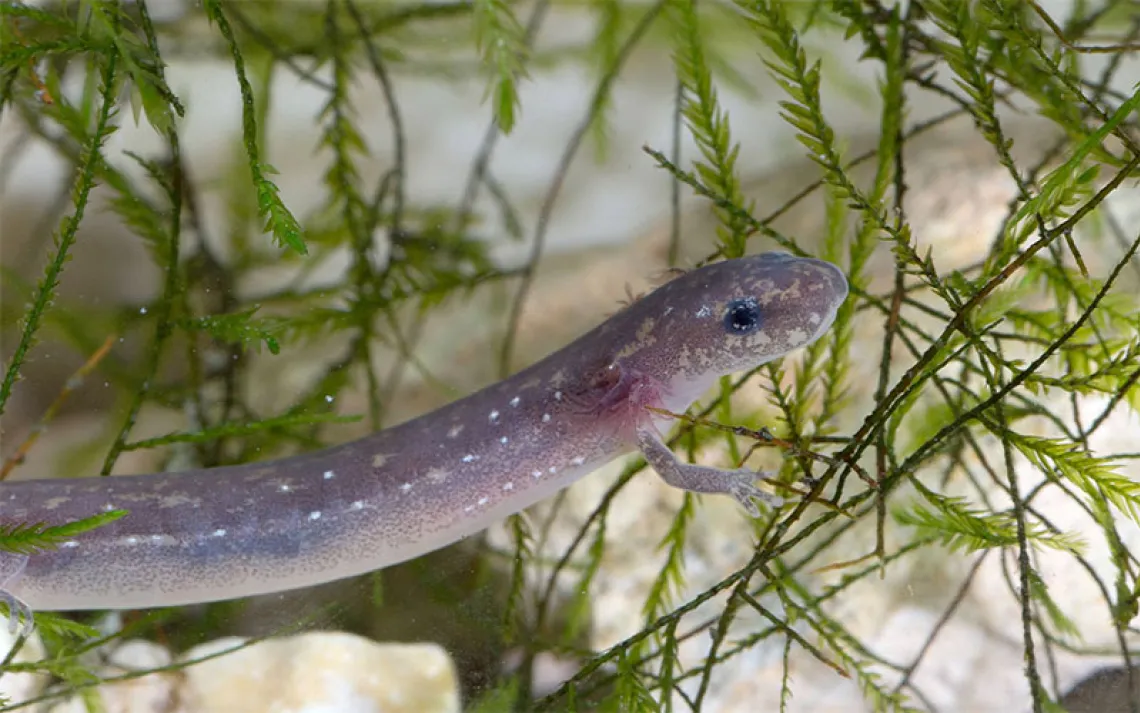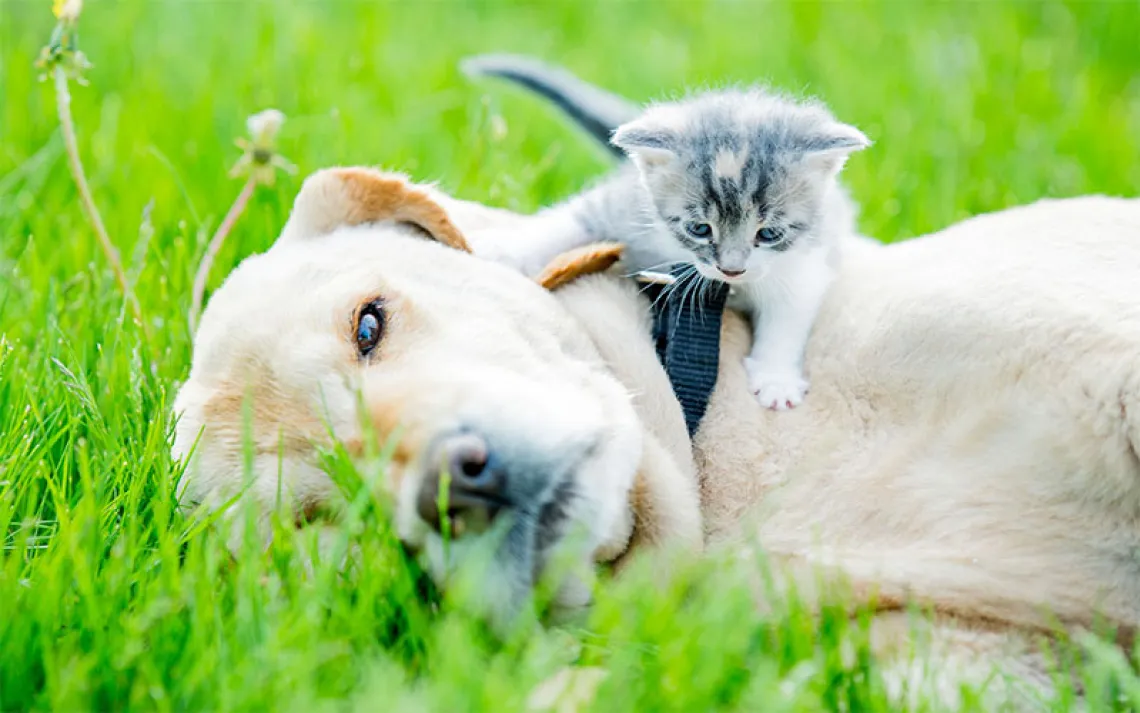Along Came a Spider
Biomimicry: Why tinker with nature when you can copy it?

Backed by billions of dollars in research funding, geneticists are altering nature at its most fundamental level. Meanwhile, some of their less-heralded-and less-funded-counterparts in other scientific disciplines are learning to emulate the intricate design of plants and animals instead. Such "biomimetic" methods have most famously brought us the airplane (based on the aerodynamics of birds) and Velcro, which Swiss engineer George de Mestral modeled on the grappling hooks of prickly burrs.
"After 3.8 billion years of research and development, failures are fossils, and what surrounds us is the secret to survival," author Janine Benyus writes in her 1997 book Biomimicry: Innovation Inspired by Nature. "In that time, life has learned to fly, circumnavigate the globe, live in the depths of the ocean and atop the highest peaks, craft miracle materials, light up the night, lasso the sun's energy, and build a self-reflective brain . . . [all] without guzzling fossil fuel, polluting the planet, or mortgaging the future. What better models could there be?"
Benyus interviewed dozens of scientists who are following nature's example to create sustainable innovations in agriculture, medicine, and manufacturing. While one develops molecule-size solar cells modeled on the way leaves gather energy, another is examining the adhesive properties of the blue mussel to make a waterproof superglue. In the following adaptation from her book, Benyus introduces us to Christopher Viney, now a professor of materials chemistry at Scotland's Heriot-Watt University, who is studying the way spiders make their incredibly strong silk for its possible applications in manufacturing. It's a steamy 80 degrees in Christopher Viney's lab, in deference to Tiny, a six-inch-long golden orb-weaver spider (Nephila clavipes),who is now flipped on her back, dining on crickets while being silked. A gossamer thread issues from her enormous abdomen at a steady clip, wound by a motor onto a revolving spindle. In this session alone, Tiny will donate about 100 feet of "dragline," a specialty silk designed for rappelling from drop-offs and framing the spokes and perimeter of her web.

Sign up to receive Sierra News & Views
Get articles like this one sent directly to your inbox weekly.
With this action you affirm you want to receive Sierra Club communications and may vote on policy designated by the Sierra Club Board.
Compared ounce for ounce with steel, dragline silk is five times stronger, and much tougher than the Kevlar in bulletproof vests--able to absorb five times the impact without breaking. But to make Kevlar, we pour petroleum-derived molecules into a pressurized vat of concentrated sulfuric acid and boil it at several hundred degrees Fahrenheit in order to force it into a liquid crystal form. We then subject it to high pressures to push the fibers into alignment as we draw them out. The energy input is extreme, the toxic by-products odious. The spider manages to make its fiber at body temperature, without high pressures, heat, or corrosive acids.
Besides being exceedingly strong, spider silk also manages to be highly elastic, a combination that is rare in any one material. If you suspend increasingly heavy weights from a steel wire and a silk fiber of the same diameter, their breaking point is about the same. But if a gale-force wind blows, the strand of silk will do something the steel never could; it will stretch 40 percent beyond its original length and bounce back good as new. Up against our stretchiest nylon, spider silk bungees 30 percent farther.
Another characteristic in spider silk's favor is that it has to get very cold before it becomes brittle enough to break easily. In the frigid temperatures that parachutes encounter, for instance, spider silk would make ideal lightweight lines. Other uses would be cable for suspension bridges, artificial ligaments, and sutures. But how would we fit so much function into such a small package? Spider silk begins as a pool of raw liquid protein sloshing around in a gland that Viney says looks like "the business end of a bagpipe." The raw silk travels from the gland to a narrow duct before being squeezed through one of the six spinnerets--minute groups of nozzles at the spider's back end. What goes into the spinneret as soluble liquid protein somehow emerges as an insoluble, nearly waterproof, highly ordered fiber. "It's enough to make a fiber manufacturer very jealous," Viney says.
Viney hypothesizes that as the raw liquid silk squeezes through the duct, water is wrung out of the protein and calcium is added. (Calcium is what allows globules of actin--a self-assembling protein that helps form our muscles--to connect, so Viney thinks it may also be at work here.) The globules hook up in a pop-bead necklace, making the solution 1,000 times less viscous, because the rodlike assemblies can now slide past one another. It's analogous to putting lanes of traffic on a highway, versus the mess that is a laneless, lawless Manhattan jam. Connected, aligned molecules are not only easier to push through the spinneret, they are also more susceptible to the shearing action that turns liquid protein into fiber. The final product is partly flexible and partly rigid, like a reinforced Slinky.
If we could learn to do what the spider does, we could make a super-strong fiber with negligible energy inputs and no toxic outputs. Imagine what that processing strategy would do to our fiber industry, which is now heavily dependent on petroleum. To break that dependency, says Viney, we have to become spiders' apprentices: "If we want to manufacture something that's at least as good as spider silk, we have to duplicate the processing regime that spiders use. It's the physical journey from the glands to the spinnerets that helps impart a certain microstructure to the fibers."
"When we scale this journey up for industrial use," Viney says, "we have to be able to give the manufacturing crew exact specifications: what concentration of protein they should use, how big the rods in the liquid crystal should be, how much calcium they will need, how much water they should squeeze out, and how fast they should spin out the fibers. By tweaking any one of those variables, we may be able to customize the silk for different uses."
All of our current knowledge comes from studies of only two kinds of threads, spun by fewer than 15 species of orb weavers, a subset that makes up only one tenth of more than 40,000 spider species. Is an even better prototype waiting out there somewhere? When I pose this question to Viney, his normally cheerful, mischievous face clouds. He thinks carefully. As in all of biology, models are chosen because they are easy to work with, he explains, and to some extent because other people have already set the track for you. But yes, there probably is a stronger, tougher, stiffer fiber being produced right this minute by a spider that we know nothing about. A spider whose habitat may be going up in smoke. For the first time all day, we check the clock.
This article was adapted from the book Biomimicry: Innovation Inspired by Nature by Janine M. Benyus. Copyright (c) 1997 by Janine M. Benyus. Reprinted by permission of William Morrow and Company, Inc., an imprint of HarperCollins Publishers.
 The Magazine of The Sierra Club
The Magazine of The Sierra Club



